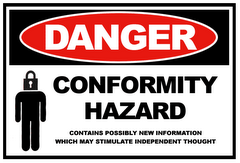Indicators Ad Infinitum
I frequently receive messages asking for my opinion about the relative value of this new indicator vs that new indicator. I am very flattered by the assumption that I can immediately rank all the known indicators on a scale of one to ten and then provide meaningful insight on their relative value. Those that ask for this information are sometimes disappointed when I am unable to respond appropriately by perhaps replying that I am certain indicator A is twice as good as indicator B. Unfortunately the truth is I do not spend much of my time researching new indicators nor do I believe that indicators can be compared in this fashion.
Regarding new indicators in general, in my opinion the world of technical analysis has too many indicators already and it doesn't need any more indicators without purpose. Everyone wants to add more indicators and more confusion. Why? I think that every new indicator should be required to come with an explanation of why it was created. What specific problem does it solve? Any new indicator that solves a particular problem should then be welcomed with open arms. Any indicator that was designed simply to be different is less than worthless. It does nothing but add to the existing confusion and serves to distract us from indicators that have proven value. Everyone should realize that in this business we keep score based solely on profits. There are no style points or bonuses for originality.
The new indicator questions I receive usually go something like this: "I just read about Joe Guru's new Joe Guru #62 which he calls the Joe Guru Upside Down Inside Out Infinitely Smoothed Fractal Precipitator with Semi Log Analysis and a Twist of Lime. Do you think this a good indicator?" (By the way, have you noticed that Gurus always have to put their names on their indicators. I think its just some Guru thing. Perhaps a grasp for immortality. In any case, let's forget about the Guru's annoying insistence on naming indicator after indicator after themselves and get back to trying to objectively assess the value of the indicator itself.) "Is it a good indicator?" was the simple question.
The answer, however, is not as simple as the question. For example: Do I think moving averages are good indicators? Yes, as trend identifiers and setups, I think they are wonderful. Do I think moving averages are awful? Yes, I have tested enough of them as entry triggers to state that they are indeed awful. I could go on and on, indicator by indicator. Most indicators are valuable when applied to certain limited tasks and also very poor at many other tasks.
We should keep in mind that indicators are not systems and they should not be evaluated in the same manner as a system might be evaluated. Indicators are nothing more than problem solving tools and there are many problems to be solved when designing a good system. Our favorite indicator may solve one of these problems perfectly but may have no value whatsoever when applied to the next problem. It is true that, in theory, you can take any indicator and make a system out of it. But the result, even with the best indicator, is usually a mediocre system. It seems to me that using this procedure assumes that you already know the answers without ever having defined the problems. Just for fun, the next time you are in the local drug store, go to the pharmacist and ask "What is your best prescription?" Tell me what kind of response you get.
Another aspect of ranking and comparing indicators is that indicators are difficult to test objectively unless you isolate their use to a particular function and then test them for their usefulness according to how well they perform that single function. For example you will remember that in our book we tested a lot of indicators as entry triggers and found that most of them were lousy. This doesn't mean they are lousy indicators. It simply means that they are lousy when used as entry triggers. Unfortunately most traders assume that the only function of an indicator is to use it as an entry trigger.
I think that if we begin to think of indicators as problem solving tools and not as systems they will begin to take on a new life and new meaning. There is no "best"or "worst" or "better than". There are trading problems that need to be solved and there are indicators that provide us a choice of solutions. The best indicator is the indicator that, at this moment, provides the best solution to the problem at hand. As we continue to put the pieces of our system together we will be faced with other problems and today's solution may not be the best solution for tomorrow's problem.
The next time you are building a system, don't start by asking: What indicator am I going to use? Instead begin by breaking down the trading process into a series of clearly identifiable problems. Then use your knowledge of various indicators to find the tool that does the best job of solving each problem. I'll bet the indicator you select is not going to be the super duper Guru namesake of the month.
Chuck Lebeau is the co-author of Computer Analysis of the Futures Market, and the former co-editor of Technical Traders Bulletin. Chuck is currently operates a website devoted to trading topics; www.traderclub.com.

No comments:
Post a Comment